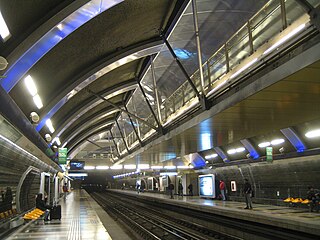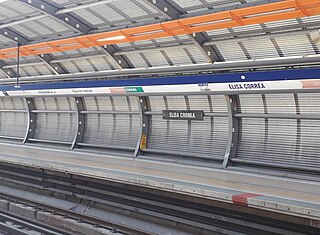
Tobalaba is a station on the Santiago Metro in Chile, the northern terminus of Line 4 and is the closest station to the Costanera Center.

Parque Bustamante is an underground metro station on the Line 5 of the Santiago Metro, in Santiago, Chile. It is located beneath Parque Bustamante, which gives the name to the station. The station was opened on 5 April 1997 as part of the inaugural section of the line, from Baquedano to Bellavista de La Florida.

Cristóbal Colón is an underground metro station on the Line 4 of the Santiago Metro, in Santiago, Chile. This station is named for Cristóbal Colón Avenue, which in turn was named after Christopher Columbus. The station was opened on 30 November 2005 as part of the inaugural section of the line between Tobalaba and Grecia.

Francisco Bilbao is an underground metro station on the Line 4 of the Santiago Metro, in Santiago, Chile. It is located under the intersection of Tobalaba Avenue and Francisco Bilbao Avenue. The latter avenue, which is named after Francisco Bilbao, gives its name to the station. The station was opened on 30 November 2005 as part of the inaugural section of the line between Tobalaba and Grecia.

Príncipe de Gales is an underground metro station on the Line 4 of the Santiago Metro, in Santiago, Chile. South of this station, Line 4 runs under Américo Vespucio Avenue, which in this section takes the name of Ossa Avenue. The station was opened on 30 November 2005 as part of the inaugural section of the line between Tobalaba and Grecia.

Simón Bolívar is an underground metro station on the Line 4 of the Santiago Metro, in Santiago, Chile. It is named for the nearby Simón Bolívar Avenue, which in turn is named after Simón Bolívar. The station was opened on 30 November 2005 as part of the inaugural section of the line between Tobalaba and Grecia.

Plaza Egaña is a transfer station between the Line 3 and Line 4 of the Santiago Metro. It is located under Egaña Square. The Line 4 station was opened on 30 November 2005 as part of the inaugural section of the line between Tobalaba and Grecia. The Line 3 station was opened on 22 January 2019 as part of the inaugural section of the line, from Los Libertadores to Fernando Castillo Velasco.

Monte Tabor is a metro station on the Line 5 of the Santiago Metro, in Santiago, Chile. The station was opened on 3 February 2011 as part of the extension of the line from Pudahuel to Plaza de Maipú. It is one of the three stations built on a viaduct on the just mentioned extension.

Bellavista de La Florida is an underground metro station on the Line 5 of the Santiago Metro, in Santiago, Chile. The station was opened on 5 April 1997 as the southern terminus of the extension of the line from Baquedano. It has served as the southern terminus of the Line 5 until Vicente Valdés metro station was opened on November 30, 2005. Despite their closeness, there is no direct connection between Bellavista and Vicuña Mackenna metro station.

Plaza de Maipú is an underground metro station on Line 5 of the Santiago Metro, in Santiago, Chile. The station is located under the Plaza de Armas of Maipú. It was formerly the deepest station in the Santiago Metro system at 28 metres (92 ft) deep. However, this has since been surpassed by the Line 3 platforms at Puente Cal y Canto station. The station was opened on 3 February 2011 as the southwestern terminus of the extension of the line from Pudahuel to Plaza de Maipú.

Trinidad is an elevated metro station on the Line 4 of the Santiago Metro, in Santiago, Chile. The side platforms and tracks are wrapped in a large elliptical cross section tube. The station has a mezzanine area below the tracks. The station was opened on 30 November 2005 as part of the inaugural section of the line between Vicente Valdés and Plaza de Puente Alto.

Los Quillayes is an elevated metro station on the Line 4 of the Santiago Metro, in Santiago, Chile. It named for the neighborhood where it is located. The station was opened on 30 November 2005 as part of the inaugural section of the line between Vicente Valdés and Plaza de Puente Alto.

Universidad de Santiago is an underground metro station on the Line 1 of the Santiago Metro, in Santiago, Chile. Is named for the nearby University of Santiago. The station is adjacent to the Evangelical Cathedral of Santiago and to the main bus stations in the city. It was opened on 15 September 1975 as part of the inaugural section of the line between San Pablo and La Moneda.

Los Orientales is an underground metro station on the Line 4 of the Santiago Metro, in Santiago, Chile. The station was opened on 30 November 2005 as part of the inaugural section of the line between Tobalaba and Grecia.

Santiago Metro Line 2 is one of the seven rapid transit lines that currently make up the Santiago Metro network in Santiago, Chile. It has 22 stations and 20.7 km of track. The line intersects with Line 1 at Los Héroes, with the Line 3 at Puente Cal y Canto, with Line 4A at La Cisterna, with Line 5 at Santa Ana, and Line 6 at Franklin. It will also intersect with the future Line 7 at Puente Cal y Canto. Its distinctive colour on the network map is banana yellow.

Elisa Correa station is an elevated metro station located on the overhead section of Line 4 of the Santiago Metro, in Santiago, Chile. The station is located on the boundary between the communes of Puente Alto and La Florida, and is the last station of the line 4 on the Cordillera province heading into the center of Santiago. It is named after the street where it is located, the junction of Elisa Correa Sanfuentes Street to the west, Los Toros Venue to the east and Vicuña Mackenna Avenue to the north and Concha y Toro Avenue to the south.

Las Mercedes is an underground metro station located on Line 4 of the Santiago Metro, in Santiago, Chile. It lies opposite Concha y Toro Avenue between Independencia Street and Domingo Tocornal Avenue. The station was opened on 30 November 2005 as part of the inaugural section of the line between Vicente Valdés and Plaza de Puente Alto.

Protectora de la Infancia station is an elevated metro station located on the overhead section of Line 4 of the Santiago Metro, in Santiago, Chile. It named after the Protectora de la Infancia children's charity, whose headquarters are just opposite the station.

Hospital Sótero del Río station is an elevated metro station located on the overhead section of Line 4 of the Santiago Metro, in Santiago, Chile. It is named after the Sótero del Río Hospital, which is directly surrounding the station. The station is located in Concha y Toro Avenue near its junction with Gabriela Avenue.

Zapotitlán is a station of the Mexico City Metro in the town of Santiago Zapotitlán and in the colonia (neighborhood) of Conchita Zapotitlán, in Tláhuac, Mexico City. It is an elevated station with two side platforms, served by Line 12, between Nopalera and Tlaltenco stations. The station's pictogram features the glyph of Santiago Zapotitlán, which shows a toothed sapote tree with three branches. The station was opened on 30 October 2012, on the first day of service between Tláhuac and Mixcoac stations.





















